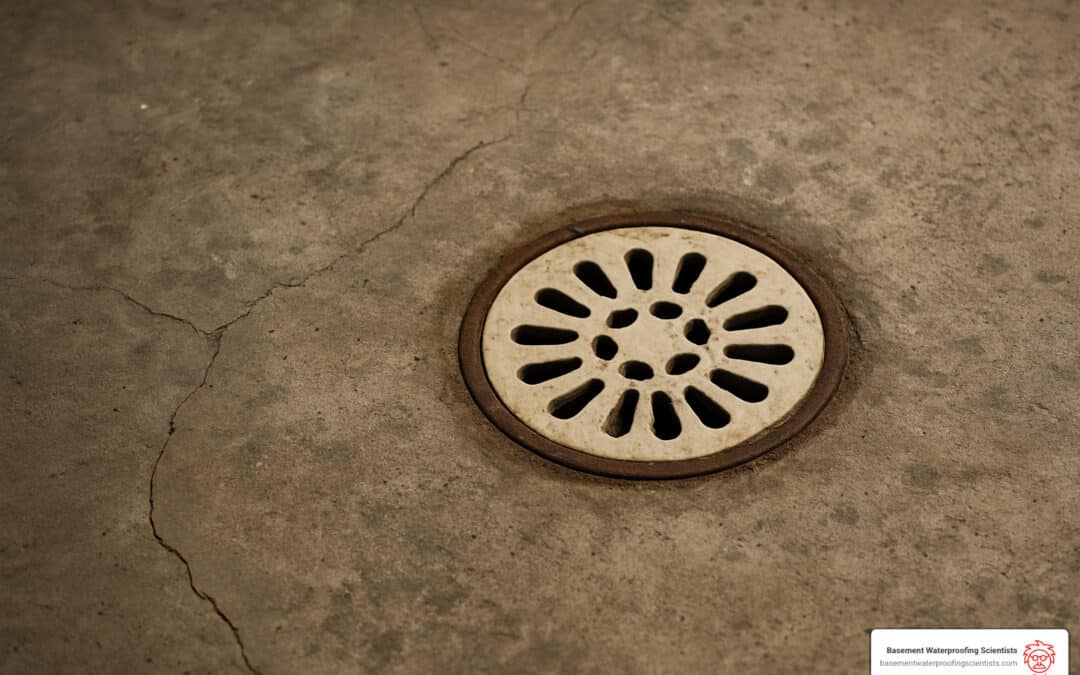Understanding the Critical Role of Basement Drains
Basement drains are the quiet workhorses beneath your feet. Installed in the concrete floor, they collect and redirect water before it can soak into walls, ruin belongings, or trigger mold growth.
Quick Guide:
- Purpose – Capture surface- and groundwater before it floods the room
- Common styles – Floor, French, trench, baseboard, and sump pit systems
- Outlet – Either a municipal sewer line or a sump pump discharge
- Why it matters – Avoids structural damage, mold, and expensive restoration
- Care – Keep clean, keep the trap wet, and inspect quarterly
The American Society of Home Inspectors estimates nearly 60 % of U.S. homes experience below-grade moisture. In the Philadelphia area—where Basement Waterproofing Scientists has worked for 30 years—proper drainage is rarely optional. A routinely inspected drain can mean the difference between a quick mop-up and a five-figure repair bill.

Related reading:
How a Basement Floor Drain Works
Water seeks the lowest point, so builders install the drain at that spot and slope the concrete about 1/4 in. per foot toward it. Once water drops through the grate it passes a P-trap (blocking sewer gas) and then either:
- Ties into the home’s waste line, or
- Falls into a sump pit, where a pump discharges it safely outside.
Key parts under the grate:
- Drain body & grate – Plastic or cast-iron housing that you see on the floor.
- P-trap – Holds a water seal to stop odors.
- Clean-out port – Allows snaking without demolition.
- Optional backwater valve – Closes if city sewers surge.

Where does the water originate?
- Leaking water heaters or washing-machine hoses
- Groundwater forced up by hydrostatic pressure
- Condensate from HVAC equipment
Even 40 gallons from a ruptured heater can stay harmless if the drain is clear—something we’ve witnessed countless times in Philadelphia basements.
Why Basement Floor Drains Matter
A functioning drain isn’t decoration—it’s insurance for your foundation.
• Foundation protection – Water expands when it freezes, turning hairline cracks into structural threats.
• Hydrostatic relief – Drainage lowers pressure so water isn’t squeezed through the cove joint or wall pores.
• Code & resale – Modern codes demand basement drainage near water-producing appliances. Buyers and insurers look for it, too.

Health & Cost
Even a thin film of water creates a paradise for mold spores and dust mites. Cleanup after a minor flood can run $1,200–$5,000; serious mold remediation adds thousands more. In contrast, preventive waterproofing from Basement Waterproofing Scientists typically falls between $4k and $8k and includes a lifetime guarantee.
Types of Basement Drains & How to Choose
| Drain Type | Best For | Typical Cost |
|---|---|---|
| Standard floor drain | New builds, appliance leaks | $500–$1,500 |
| French drain (interior) | Persistent wall & floor seepage | $3,000–$6,000 |
| Curtain drain | Moderate wall moisture | $2,000–$4,000 |
| Trench/channel | Doorways, garage steps | $1,000–$3,000 |
| Baseboard drain | Finished basements (minimal demo) | $2,000–$5,000 |
| Sump pit + pump | High water tables | $1,200–$4,000 |

Interior French drains remain our go-to in the Mid-Atlantic because they intercept water along the footing yet avoid exterior excavation. For finished spaces, low-profile baseboard drains keep walls intact.
When we visit your home we check: Is the basement finished? Where does water enter? How high is the local water table? Then we tailor the solution—no one-size-fits-all guesses.
Maintenance, Troubleshooting & Upgrades
Five-minute quarterly routine:
- Pop the grate, remove debris.
- Pour a bucket of water to test flow and re-fill the trap.
- Sniff—musty odor means the trap dried out; refill it.
Annual check-list:
- Inspect backwater valve.
- Test sump pump and battery backup.
- Add water alarm if valuables are stored nearby.
DIY fixes for slow drains:
- Plunger first.
- ½ box baking soda + 2 c vinegar, wait 15 min, flush hot water.
- Handheld snake for reachable clogs.

If water backs up during heavy rain, the problem may be a sewer surcharge. A backwater valve—or a full interior system with a Sump Pump for Basement—usually cures it.
Installation & Code Essentials
Most jurisdictions require:
- 2-in. minimum drain opening
- 1/4-in. per foot floor slope toward the drain
- P-trap with venting
- Backwater valve if tied to sanitary sewer
- Permit and inspection before covering work

Retrofitting
Concrete cutting, rubble removal, and tie-ins make retrofits costlier than new-build installs ($4k–$8k on average). Our crews use dust-controlled saws and haul the debris so your home stays livable.
Back-Up Prevention
Lift septic or sewer laterals below basement grade, keep trap primers working, and never dump gutter downspouts into sanitary lines. Simple battery-powered alarms give early warning before possessions are lost.
Frequently Asked Questions
How do I know my basement drain is clogged? Gurgling fixtures, foul odors, slow flow, or water pooling around the grate are red flags.
Can I hide the drain when finishing? You shouldn’t eliminate it, but you can fit an attractive grate or build a removable floor panel for access.
Is a floor drain always required? New construction almost always says yes—especially near water heaters and HVAC equipment. Older homes may be grandfathered in, but any major remodel usually triggers an upgrade requirement.
Conclusion
A reliable basement drain is cheaper than one water-damage claim and safeguards your home’s structure, air quality, and resale value. Basement Waterproofing Scientists serves Philadelphia, Reading, Norristown, and surrounding PA, NJ & DE communities with inspections, customized systems, and lifetime warranties.
Need help? Call us at (610) 615-7111 or request a free inspection via our guide to basement drainage systems. A dry basement today means fewer worries—and expenses—tomorrow.


